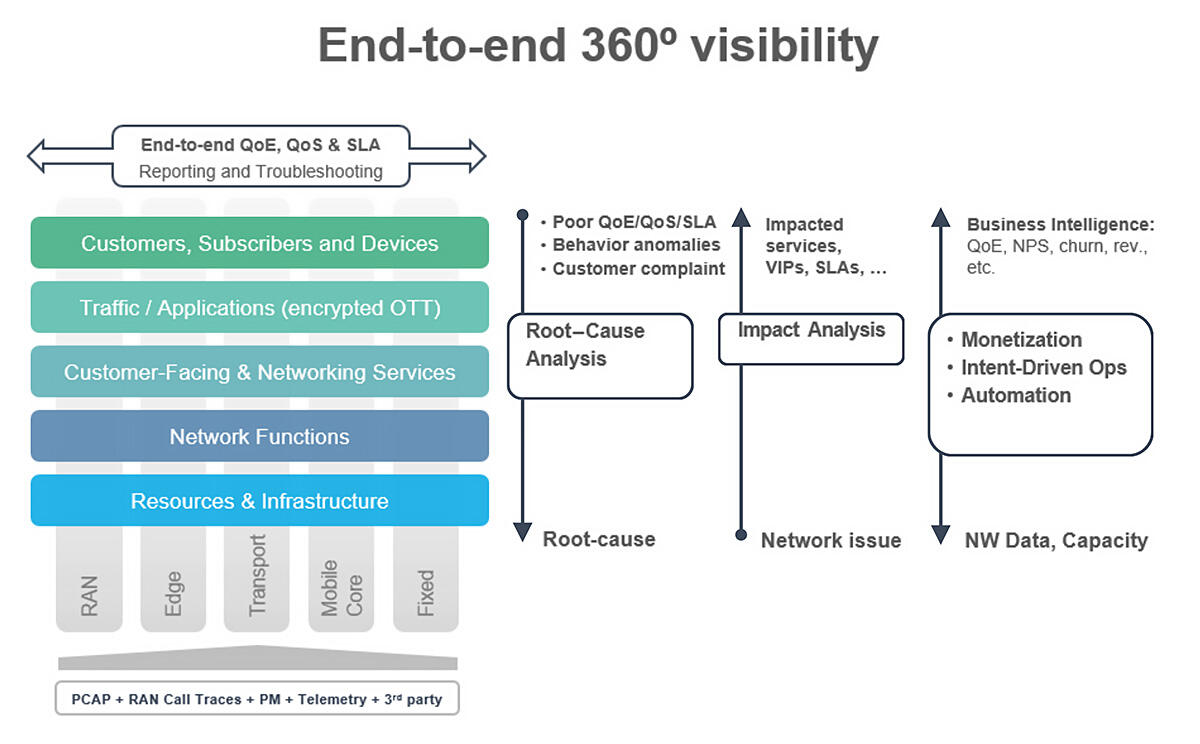Every operator knows that automation is essential to cope with the scale and complexity of modern telecom networks. But most are still yet to achieve true end-to-end automation. The reason is simple: you can’t automate what you can’t see.
That’s why unified visibility in telecom networks is becoming essential.
Today’s 5G and cloud-native networks are multi-vendor, multi-domain and highly dynamic. Traffic shifts between physical and virtualized environments, between public and private clouds, and between mobile and fixed access networks. Each of these layers has its own tools, metrics and data formats.
When these systems remain siloed, network and service operations lose the very foundation on which automation depends, which is a unified, accurate and contextual view of what’s happening across infrastructure, services and customers.
Without cross-domain intelligence, automated workflows break down at domain boundaries, and engineers are forced back into manual correlation and ticketing.
The foundation of autonomous networks is observability
From monitoring to observability: evolving network visibility
Legacy assurance tools were designed to monitor networks, not to deliver real-time business analytics or support dynamic service orchestration and closed-loop automation. They focus on collecting and displaying data, not interpreting it. The result is that operations teams are drowning in metrics but starved for insight.
In contrast, next-generation “observability” in telecom extends visibility both horizontally, from RAN to edge to transport to core, and vertically, from infrastructure and network functions through encrypted OTT services to the end-subscriber, along with encompassing the operator’s technologies, including fixed, 4G, 5G, FWA and IoT.
As experts agreed on an industry panel sharing growth and innovation strategies for operators, full-stack observability means the ability to correlate RAN call traces, OSS telemetry and packet probes in real time. Only by fusing telemetry, packet and service data into a single operational picture can operators understand business context such as SLAs, customer insights or revenue impact.
This unified visibility enables 360° observability and real-time correlation of technical events with their service and customer impact.
For example, when a VIP customer’s video session degrades, the operator can instantly trace whether the cause sits in a congested transport/backhaul link, if it’s a coverage or quality issue in the RAN, a bottleneck in the core such as a DNS issue, or an underperforming OTT CDN/app server. And crucially, they can then use this comprehensive insight into their network to remediate the problem automatically before the customer notices.
Why automation needs a single source of truth
End-to-end automation requires a “single source of truth” that every system, from orchestrators to AI agents, can trust. Without it, closed-loop workflows cannot function reliably.
This is an architectural challenge. It requires an architecture that unifies and correlates network performance, service assurance and customer experience intelligence.
This makes assurance the brain of automation, unlocking the intelligence that powers predictive analytics, proactive assurance and, ultimately, self-healing actions.
From reactive to proactive: the shift to predictive assurance
In legacy operations, operations were reactive. People (and some basic rule-based automation) would wait for an issue to react; alarms would ring after a service impact has occurred.
In contrast, unified, contextual visibility delivers interconnected insights across network, service, and customer layers, and when coupled with machine learning, it enables a step-change toward proactive and predictive assurance.
- Automating troubleshooting and ticket management: It’s not enough to do anomaly detection and correlation, the workflow needs to be automated and integrated with ITSM systems to streamline this process from detection to resolution.
- 360° assurance with vertical correlation: By opening up visibility to network and infrastructure performance, operators can link network to service and customer/SLAs for impact analysis and seamless RCA in unified tool.
- Smart capacity management: predicting capacity bottlenecks and planning/forecasting capacity expansion needs and linking it to CX, revenue and churn.
- Proactive SLA management: By resolving issues before they violate enterprise SLAs or impact high-value VIP customers, operators can both protect revenue and customer trust.
In our experience working with leading CSPs, we’ve seen firsthand that customers adopting ML-based anomaly detection have achieved 40 percent fewer alarms and 30 percent faster incident resolution. Depending on the size of CSP, this can mean ROI breakeven in as little as a year.
It’s ensuring not just a better experience, but a more profitable one too.
We’ve seen that CSPs adopting ML-based anomaly detection have achieved 40% fewer alarms and resolved incidents 30% faster
Breaking operational silos beyond the NOC
Unified visibility, therefore, isn’t just an operational issue, it’s strategic. When data remains confined to the NOC, other business units are flying blind. Marketing cannot link network quality to churn. Enterprise sales cannot demonstrate SLA performance. Finance cannot quantify the cost of poor experience.
Exposing real-time network and service intelligence to non-technical teams, via a GenAI UI backed by secure, governed APIs, enables natural-language access to insights and value-creating business outcomes. This same capability also powers customer self-portals, turning curated insights into monetizable services and transparent, real-time SLA performance reporting.
By aligning technical and commercial perspectives, unified visibility becomes the bridge between network automation and business automation.
The path to autonomous operations with Agentic AI
Unified visibility is the cornerstone upon which today’s autonomous networks are being built. However, a move to higher-levels of autonomy above and beyond the use cases above will require AI-driven, closed-loop automation that understands intent, interprets context and can act autonomously with confidence.
This is where Agentic AI will have a crucial role to play in telecom.
Infovista’s Intelligent Agentic Framework is helping CSPs take this next step by translating natural-language queries into automated assurance actions.
Because the framework sits atop a unified, trustworthy data fabric, each automated action is explainable, auditable and aligned with business policy. This is what distinguishes safe, “human-in/on-the-loop” automation from opaque AI experimentation.
Key takeaway: unified visibility as the foundation of automation
End-to-end closed-loop automation isn’t achieved through more scripts or dashboards. It’s achieved through unified, intelligent visibility. Only when operators connect every layer of their network and correlate it with customer and business context can they automate confidently, predict accurately, and act autonomously.
In the journey from automated assurance to intent-driven autonomous networks, end-to-end, 360° visibility underpins everything.

Related Resources:










